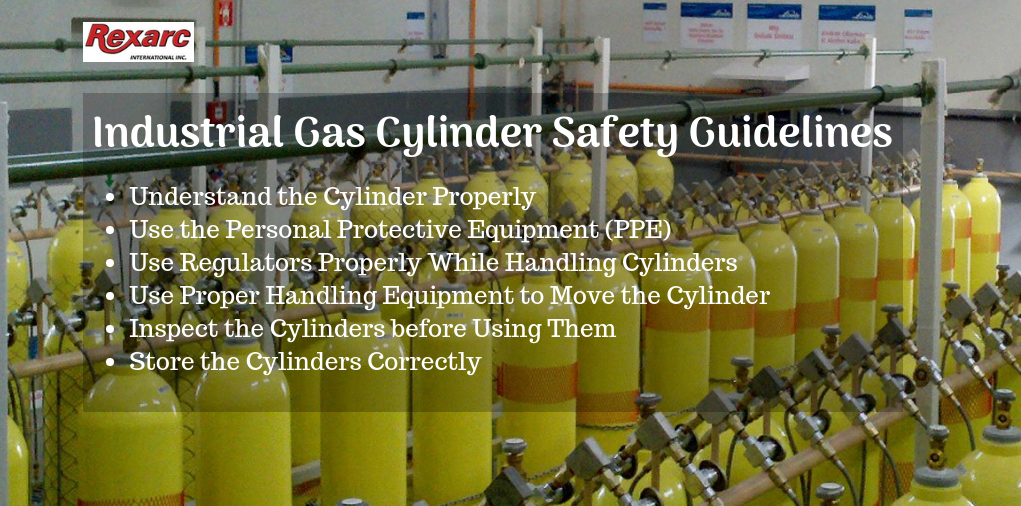Industrial gas cylinders have been around for a long time. They are widely used for welding, medical applications, fermenting liquids, and several other applications across various industries. In addition to these, new applications for these cylinders are emerging, as new industries and technologies are evolving. These cylinders are filled with low molecular weight chemicals in a gaseous form. Acetylene, oxygen, nitrogen, carbon dioxide, hydrogen, argon, and helium are some gases, which are used regularly. These chemical gases have distinct properties, which are exploited in various industrial applications. If not handled properly, these industrial gas cylinders may be hazardous in various industrial conditions. This post shares some important safety tips for handling industrial gas cylinders in an industrial facility.
Important Industrial Gas Cylinder Safety Guidelines to Keep in Mind
Acetylene and oxygen are two industrial gases widely used across various industries. The cylinders accommodating these gases are designed with user’s safety in mind. However, that is not enough to ensure optimum safety in an industrial facility. The following factors will help ensure the same:
- Understand the Cylinder Properly: A personnel should be familiar with the potential risks and hazards associated with compressed gases while handling them. It is important to understand the properties of the gas filled within such as toxicity, flammability limits, and toxicity – Threshold Limit Value (TLV). Also, it is important to understand the hazards posed by gas at low temperature, high pressure or due to the physical state of the gas – non-liquefied or liquefied, etc. A personnel should read the contents of the label on the cylinder. If the label is missing or not easily readable, then the cylinder should not be used. In addition to improving a personnel’s understanding on oxygen cylinder safety or acetylene cylinder safety, he should be administered a proper plant safety training.
- Use the Personal Protective Equipment (PPE): It is mandatory to use various appropriate PPE while handling an industrial gas cylinder. For instance, wear safety glasses, safety shoes, gas masks, and safety glasses, while working with cylinders filled with compressed gases. Similarly, it is important to use flame arrestors when using acetylene cylinders in compressed air.
- Use Regulators Properly While Handling Cylinders: Regulators are devices, which are designed to lower the working pressure of the gas. These devices differ according to gases. Many times, the regulators aren’t handled and stored properly. This improper usage may lead to problems in the long run. Hence, it is important to take several precautions while using regulators. The following tips may help:
- Use the right type of regulator for the gas cylinder.
- Take care to inspect the regulator before attaching to the cylinder.
- If the connections aren’t properly made, perhaps you might be using the wrong device. Thus, it is wise to replace it with the right one.
- Close the valve of the cylinder, as well as release the pressure from the regulator, before removing it from a cylinder.
- Remove the regulator from the cylinder while transporting it to another location.
- Use Proper Handling Equipment to Move the Cylinder: Using a proper handling equipment is important while handling the cylinder within the facility or transporting it to a different location. Always use proper Manifold Cylinder Pallets (MCPs) or cylinder trolleys when moving individual cylinders. If moved to a different location, then the vehicles or containers used for transporting must use the relevant Haz-chem code, MSDS, and TREMcards, irrespective of the color code of the cylinder.
- Inspect the Cylinders before Using Them: A stored cylinder must be inspected for any signs of impact, discoloration, heat damage or other signs.
- Store the Cylinders Correctly: The cylinders should be stored in a dry, ventilated, and well-drained area, and away from ignitable and inflammable materials. Empty cylinders must be stored separately. OSHA also mandates the facility owners to store oxygen and fuel gas cylinders separately. The storage facilities should display proper warning signs for people regarding the dos and don’ts in the area where the cylinders are stacked. Always take care to store acetylene gas cylinders, as well as other compressed gas cylinders vertically.
In addition to the above, the following should be practiced while handling the compressed gas cylinders.
- The cylinders feature tags, markings, or stencil marks for easy identification. Never deface or tamper these identification marks while using the cylinders.
- Never drag, roll, or drop cylinders during the use.
- Always take care to maintain the valve caps during the transport. Avoid lifting the cylinder using a valve cap.
- Never store the cylinders for a long time period.
- Gas cylinders should only be purchased in small quantities. Never store them for long time periods.
It is important to follow extreme precautions and safety measures while working with industrial gas cylinders due to several hazards and risks posed by them. Sourcing these cylinders from a reliable manufacturer is the most important safety measure for any facility owner using these cylinders. Rexarc International, Inc. is one of the leading manufacturers of customized compressed oxygen and acetylene cylinders, since 1924.




